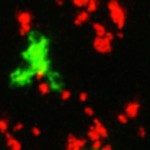Link to Pubmed [PMID] – 7542602
Eur. J. Immunol. 1995 Jul;25(7):2019-26
Transport of an immunogenic self-peptide from the second domain of the mouse major histocompatibility complex (MHC) H-2Kd class I molecule is blocked at the TAP1-TAP2 peptide pump level due to its amino acid sequence and is not presented to cytolytic T lymphocytes (CTL). We demonstrate that first, TAP1-TAP2 pumps can restrict antigen presentation by selecting against internal peptide motifs which are not involved in peptide binding to MHC class I molecules. Second, some molecules targeted to the endoplasmic reticulum are processed for MHC class I presentation in the cytosol. Third, some abundantly expressed immunogenic self-peptides are cytosolically sequestered. The advantage for the host, in terms of the peripheral T cell repertoire is that the spared CTL can be used to recognize foreign antigens. It is, however, anticipated that this advantage will be exploited by pathogens to evade immune surveillance by similar strategies.

